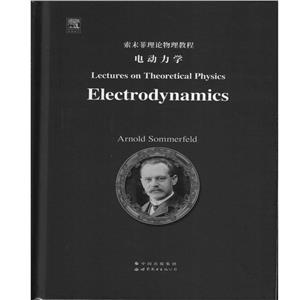扫一扫
关注中图网
官方微博
本类五星书更多>
-
>
宇宙、量子和人类心灵
-
>
气候文明史
-
>
南极100天
-
>
考研数学专题练1200题
-
>
希格斯:“上帝粒子”的发明与发现
-
>
神农架叠层石:10多亿年前远古海洋微生物建造的大堡礁
-
>
声音简史
Lectures on theoretical physics:Vol. Ⅲ:Electrodynamics 版权信息
- ISBN:9787519296803
- 条形码:9787519296803 ; 978-7-5192-9680-3
- 装帧:一般胶版纸
- 册数:暂无
- 重量:暂无
- 所属分类:>
Lectures on theoretical physics:Vol. Ⅲ:Electrodynamics 内容简介
本书是“索茉菲理论物理教程”的第三卷,主题是电动力学。“索末菲理论物理教程”包括力学、变形介质力学、电动力学、光学、热力学与统计物理、物理学中的偏微分方程六卷,是作者给Muenchen大学和理工学院物理专业大三、大四学生讲课的手稿整理而成的。索末菲老师教书是物理数学融合在一起的,关键是他还能实验物理和理论物理一起教。索末菲的教学应该是深刻地影响到了不少人。他的教学非同于一般的教书匠,其教科书里融入了自己的理解还有自己对学术的贡献。索末菲对物理学的贡献是多方面的,即便面对爱因斯坦这样的人物,也未必逊色多少。
Lectures on theoretical physics:Vol. Ⅲ:Electrodynamics 目录
Preface
Translator's Note
PART I. FUNDAMENTALS AND BASIC PRINCIPLES OF MAXWELL'S ELECTRODYNAMICS
§1. Historical Review. Action at a Distance and Action by a Field Biographical Notes
Michael Faraday, 1791
James Clerk Maxwell, 1831
André Marie Ampère, 1775-1836
Heinrich Hertz, 1857-1894
§2. Introduction to the Basic Concepts of the Electromagnetic Field
§3. Maxwell's Equations in Integral Form
§4. The Maxwell Equations in Differential Form and the Material Constants of the Theory
1. Conductivity and Ohm's Law
2. Dielectric Constant
3. Permeability
§5. Law of Conservation of Energy and Poynting Vector
§6. The Role of the Velocity of Light in Electrodynamics
§7. The Coulomb Field and the Fundamental Constants of Vacuum. Rational and Conventional Units
A. Electrostatics
B. Magnetostatics
C. Rational and Conventional Units
D. Final Determination of the Fundamental Constants eo, uo in the MKSQ System
§8. Four, Five, or Three Fundamental Units
A. Supplementary Note on Our System of Four Units
B. The Five Units MKSQP
C. The Gaussian System of Only Three Units
D. Supplement Regarding Other Systems of Units
PART II. DERIVATION OF THE PHENOMENA FROM THE MAXWELL EQUATION
§9. The Simplest Boundary-Value Problems of Electrostatics
A. Charging Problemg
B. Induction Problems and Method of Reciprocal Radii
C. Conducting Sphere in a Uniform Field
D. Dielectric Sphere in a Uniform Field
E. Reflection and Refraction of Lines of Force at the Boundary of a Semi-infinite Dielectric
§10. Capacity and Its Connection with Field Energy
A. The Plate Condenser
B. Spherical Condenser
C. Capacity of an Ellipsoid of Revolution and of a Straight Piece of Wire
D. Energetic Definition of Capacity
E. The Capacities in an Arbitrary System of Conductors
§11. General Considerations on the Electric Field
A. The Law of Refraction for the Lines of Force
B. On the Definition of the Vectors E and D
C. The Concept of Electric Polarization; the Clausius-Mossotti Formula
D. Supplement to the Calculation of the Polarization
E. Permanent Polarization
§12. The Field of the Permanent Bar Magnet
§13. General Considerations on Magnetostatics and Corresponding Boundary- Value Problems
A. The Law of Refraction of the Lines of Magnetic Excitation
B. Definition of the Vectors H and B, Particularly in Solid Bodies
C. The Magnetization M in Any Non-Ferromagnetic Substance
展开全部
Lectures on theoretical physics:Vol. Ⅲ:Electrodynamics 作者简介
Arnold Sommerfeld(1868-1951),是德国伟大的理论物理学家,大师之大师,学生中有包括海森堡和泡利在内的6位诺贝尔奖得主。他一生著述丰富,其中之一就是由他给Muenchen大学和理工学院物理专业大三、大四学生讲课的手稿整理的六卷理论物理教程,包括:力学、变形介质力学、电动力学、光学、热力学与统计力学和物理学中的偏微分方程,已被译成英文、法文和俄文等其他文种出版,课程的核心是经典物理学。
书友推荐
- >
烟与镜
烟与镜
¥18.3¥48.0 - >
上帝之肋:男人的真实旅程
上帝之肋:男人的真实旅程
¥20.2¥35.0 - >
朝闻道
朝闻道
¥14.8¥23.8 - >
二体千字文
二体千字文
¥14.0¥40.0 - >
人文阅读与收藏·良友文学丛书:一天的工作
人文阅读与收藏·良友文学丛书:一天的工作
¥15.7¥45.8 - >
伯纳黛特,你要去哪(2021新版)
伯纳黛特,你要去哪(2021新版)
¥16.9¥49.8 - >
我从未如此眷恋人间
我从未如此眷恋人间
¥16.9¥49.8 - >
罗曼·罗兰读书随笔-精装
罗曼·罗兰读书随笔-精装
¥32.9¥58.0
本类畅销
-
世纪幽灵-走近量子纠缠
¥9.4¥28 -
大学物理简明教程·第4版
¥34.6¥56 -
物理学之美-插图珍藏版
¥29¥69 -
一代神话:哥本哈根学派
¥7.2¥15.5 -
现代炼金术的兴起:卡文迪什学派
¥7.4¥16.8 -
核科学基本原理
¥15.7¥39.8
浏览历史
基础教育信息化发展指数
¥65.1¥89.0黏土类工程屏障重金属污染物阻滞理论与应用研究
¥47.8¥78.0页岩气地震勘探技术
¥86.1¥118.0铜基电触头材料物理化学基础
¥55.6¥88.0

















